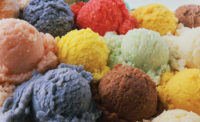
Whether it’s getting scoops at the local scoop shop, trying out the new sundae at a carnival or chasing down the ice cream truck for a bevy of sweet treats, ice cream and summertime go hand in hand. Many processors are even ramping up marketing promotions and pairing them with big summertime savings to boost sales. (Check out Marina Mayer’s Marketing Musings blog on www.dairyfoods.com to see what processors are doing.)
In fact, Americans consume about 23.2 quarts of ice cream, ice milk, sherbet, ices and other commercially produced frozen dairy products a year, according to a recent study by Chicago-based Mintel.
“According to The International Ice Cream Association [a constituent organization of the International Dairy Foods Association, Washington, D.C.], the U.S. ice cream industry generates billions in annual sales and provides jobs for thousands of citizens,” says Ellen Schack, founder and CEO of Cowabunga Ice Cream, Forked River, N.J. “They report that about 9% of all the milk produced by U.S. dairy farmers is used to produce ice cream, contributing significantly to the economic well-being of the nation's dairy industry.”
This means that ice cream is here to stay. Or is it?
Even the best-tasting ice cream and money-saving opportunities can’t beat the heat, as indicated in data from Chicago-based SymphonyIRI Group.
In the 13 weeks ended June 27, 2010, overall ice cream sales began to skyrocket, rising to $1,038.4 million but down 6% compared to the previous period.
But ice cream is a seasonal treat. When the snow began to fall, so did sales. In the quarter ending Dec. 26, 2010, sales dipped to $881 million, with a 2.5% drop since last year.
However, the next quarter (ending March 27, 2011) provided a bit of a bump to $921.4 million, which is a $15 million increase from the quarter ending March 28, 2010. This past quarter also experienced a 1.7% rise in sales from last year, which could set the stage for a pattern of higher sales figures.
Processors get in the mix
Private-label products continue to snag the No. 1 position within the close to $4 billion ice cream category. Breyers, produced by Unilever, Englewood Cliffs, N.J., maintained the No. 2 spot with $419.4 million in sales, quarter ending March 27, 2011, thanks to its recent introduction of Breyers Blasts, a lineup of ice cream options paired with notable cookie and candy brands, such as Mrs. Fields, Oreo, Whoppers and Chips Ahoy! However, Breyers experienced a 5.1% drop in sales from last year.
Dreyer’s, produced by Nestlé USA, Glendale, Calif., claimed the No. 4, 7 and 8 slots for its Edy’s Slow Churned, Edy’s Fun Flavors and Edy’s Grand brands, respectively. However, these products underwent some hurdles along the way. While the Edy’s Slow Churned umbrella of products dipped 6.3% in sales, its new offering of parlor-style shakes and smoothies in eight flavors may fill the void. Sales of Edy’s Grand ice cream also declined 12.3% since last year.
On the other hand, Edy’s Fun Flavors rose 19.2% in sales, most likely due to its new flavors-Triple Cookie Fudge Sundae and Black Raspberry Limited Edition.
Other noteworthy jumps in sales include Blue Bunny, produced by Wells Enterprises, Le Mars, Iowa (9%), Blue Bell Ice Cream, Brenham, Texas (8%), Ben & Jerry’s, South Burlington, Vt. (7.7%), Turkey Hill Dairy, Conestoga, Pa. (6.4%) and Nestlé’s Häagen-Dazs, Oakland, Calif. (4.3%).
Despite the occasional sales slumps, data prove that ice cream is here to stay, regardless of the season.


